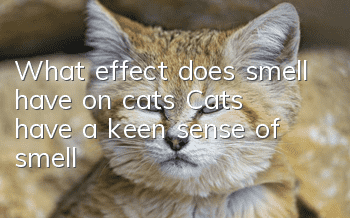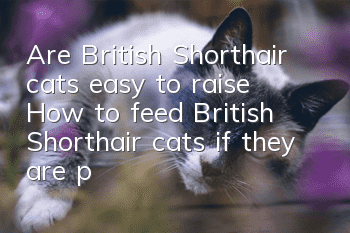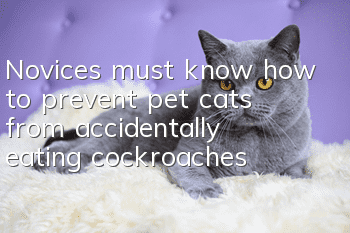What effect does smell have on cats? Cats have a keen sense of smell!

What impact does smell have on cats? Cats’ sense of smell is far more developed than ours. Cats use the sense of smell to perceive the environment and become familiar with it. At the same time, they use the sense of smell to find food. When courting, cats use it to smell hundreds of meters away. It can detect the smell emitted by cats of the opposite sex outside the home, and can follow this smell to contact each other. Therefore, smell and smell play many roles in cats’ lives.
Cats like to rub their owners with their bodies, so that their own body odor can stay on their owners so that they can distinguish it. When you meet a cat you don't know, the first thing you should do is smell the tip of its nose and tail. If "the words don't make sense", then "fight with fists and feet" and start a biting fight. The winner will be calm, have their hair erect and their back arched. The cat, who looked like he was about to lose, fell on his back in defeat.
The cat’s sense of smell is realized by the olfactory nerve distributed on the mucosa in the back of the nasal cavity and in the cribriform cells. The olfactory mucosa covers an area of 20 square centimeters to 40 square centimeters, twice the size of a human being. It contains more than 200 million olfactory cells and can smell musk odor diluted to one part 8 million. When the odor enters the nasal cavity with the inhaled air, it can stimulate the olfactory cells to generate excitatory impulses, which are transmitted to the brain along the olfactory nerve to cause the sense of smell. Cats' sense of smell is already highly developed when they are born, and kittens show a strong tendency to avoid bad smells. It is important that olfaction is well developed at this time, allowing young animals to find the mother cat's nipples. By the 3rd day of age, each kitten will have established a preferred nipple, mainly using scent to find and follow previous paths to find specific nipples. As vision develops (3 weeks of age), smelling becomes less important.
For adult cats, smell is an important identification mark between cats - first face to face, then face to anus. The anal epithelium contains sebaceous material that is unique to each carnivore (only carnivores have anal glands) and is similar to the human epithelium. Scent is also used to explore new environments. Certain smells can cause cats to react quickly. Some companies put odorants in the trash to prevent cats from eating it, but this isn't very effective.
To summarize, the role of cats’ sensitive sense of smell in their lives:
1. Cats living in the wild can roughly determine their prey through their sense of smell. direction to determine the direction of hunting.
2. In daily life, domestic cats can use their sense of smell to determine where food is placed.
3. Cats will smell before eating. They can use their sense of smell to distinguish spoiled, stale and poisonous food.
4. Female cats can secrete a sexual secretion when they are in heat, and male cats can use their sense of smell to find female cats, mate, and reproduce. (Referring to life in the wild)
5. Newborn kittens cannot open their eyes. They can find their mother's nipples through their sense of smell and drink milk.
Scientists have summarized the effects of 14 chemicals from different biological sources, including the smell of certain plants, on cats. The study found that when cats smell its smell, it will affect their behavior.The 3 main categories of these chemicals include 7-methylcyclopropanepyrone, 7-methyl-2-pyridine and 4-methylbenzofuran. Some of the more common plants include kiwifruit, oriental vine, valerian (asparagus), cat thyme, honeysuckle, and catnip. Cats' reactions to catnip are often thought to be related to hallucinations, as the sensation of smoking catnip in humans is similar to that of marijuana. Its active ingredient, cis-trans pseudonepetalactone, is a monoterpene that can be detected at a concentration of 1/109.
When exposed to catnip, the cat will smell it, lick it, chew or eat it. After the head trembles, stares and salivates, the cat may hold the catnip with its forelimbs and rub it with its head. Often the skin on a cat's back will tremble. If the reaction increases, the cat will rub its side. Sometimes jumping with excitement may occur. The reaction may last 5-15 minutes, with an average duration of 2.7 minutes. The feeling of satisfaction will last for 1 hour. It has been speculated, but not proven, that the smell of catnip activates central areas associated with estrous behavior because it behaves similarly to a female cat in heat.
The reaction of cats to catnip varies greatly among individuals, and about 30-50% of cats have no reaction at all. Although the reaction is autosomal dominant, it may change with age and experience. Kittens younger than 2 months old, scared and stressed will have a decreased response to mint. Estrus prolongs the reaction.
- Why does a cat take the initiative to crawl into your arms?
- Why does the kitten have diarrhea?
- Does cat grass have any effect on people?
- There is a small amount of blood in the cat's vomit
- Can cats eat shredded vegetarian steak?
- Little female cat’s name
- Can cat deworming medicine be mixed in cans and eaten?
- Symptoms and treatments of Malassezia dermatitis in pet cats
- How to make a cat defecate with intestinal obstruction
- Does it matter if the cat ate some pothos leaves?



